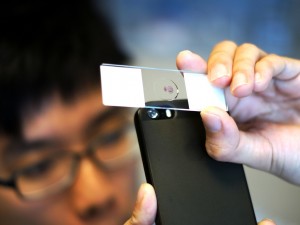Smartphones Turn Into Microscopes With $5 Dotlens
 A powerful microscope can cost you thousands of dollars, but researchers at the University of Houston have designed an amazing lens that converts the camera on your smartphone into a microscope that costs just $5. It’s called the Dotlens, and it has a campaign on Kickstarter right now.
A powerful microscope can cost you thousands of dollars, but researchers at the University of Houston have designed an amazing lens that converts the camera on your smartphone into a microscope that costs just $5. It’s called the Dotlens, and it has a campaign on Kickstarter right now.
The Dotlens was created by Wei-Chuan Shih, an assistant professor at the University of Houston. Its discovery was a welcomed accident. The lens is made from polydimethylsiloxane, a flexible material that allows the lens to work like a contact lens. During his activities working with the material, he noticed that when the material was heated up, it cured. Intrigued, he tried making a lens from it and was successful.
When he stuck the lens onto the camera of his Lumia 520, he discovered its magnification properties. In fact, when comparing its magnification ability to a professional grade Olympus microscope, there was little difference between the two. He had created a mimic of a $10,000 Olympus scope with a smartphone and materials costing just one cent.
The lens being created for the Kickstarter campaign is capable of creating a microscope capable of 15x magnification, or to one-tenth the width of a human hair. The lens is placed on the lens of the smartphone camera, where it adheres like a contact lens. It doesn’t need any special equipment to fit to a smartphone camera lens and can be used on just about any device without the risk of causing any damage. The lens can be used and removed multiple times without its adhesive qualities being compromised.
The Kickstarter campaign aims to fund the development of a special inkjet printer that will produce the lenses, which are currently produced by hand. For a $10 Kickstarter contribution, backers will receive two 15x magnification lenses for their smartphone. At the time of writing, the campaign has amassed roughly two-thirds of its goal and still has 28 days before the end of the campaign. After the end of the campaign, the price of the lenses will rise to $20 for each one, with delivery scheduled for June.
